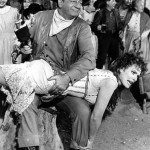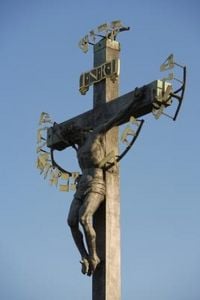This, from North Carolina:
During Rockingham County’s primary election, religion came up quite a bit.
At a meet-and-greet in Ruffin, the Rev. Jerry Carter, the Republican candidate for the N.C. House in District 65, said that the Founding Fathers never intended a separation of church and state.
His proof was, “If they did, then why did they put ‘one nation under God’ in the Pledge of Allegiance?”
The crowd applauded him, and he sat, smiling.
That’s right—Carter claimed that the Founding Fathers put “one nation under God” in the Pledge of Allegiance. Carter, by the way, won that primary. He then won the general election.
For all the Right’s adulation of the Pledge of Allegiance—which they insist our schoolchildren must recite daily—there was no Pledge of Allegiance until 1892. The Found Fathers never recited the Pledge of Allegiance. Beyond this, the words “Under God” were not added to the Pledge of Allegiance until 1954, during the Cold War.
Many Americans don’t seem to know any of this.
Back in 2006, Sarah Palin responded to a questionnaire like this:
Question: Are you offended by the phrase “Under God” in the Pledge of Allegiance? Why or why not?
Palin: Not on your life. If it was good enough for the founding fathers, its good enough for me and I’ll fight in defense of our Pledge of Allegiance.
Again—the phrase “Under God” was not added until the Pledge of Allegiance until 1954. It was not “good enough” for the Founding Fathers. They never felt the need to create a Pledge of Allegiance.
So, why do we have a Pledge of Allegiance, then? I knew the basics, but I was suddenly curious as to the timing. Why then? Why did people suddenly like the idea of a pledge, when the Founding Fathers never thought one necessary (or, likely, even thought of the idea)? As I researched this question, I found this, in the Boston Review:
The origins of the pledge cannot be understood apart from the “flag movement” of the 1880s, which itself cannot be understood apart from the Civil War. Just as U.S. (that is, Union) flags became more omnipresent during the war, so “loyalty tests” also spread. People suspected of disloyalty were often arrested, eligible for pardon if they submitted to an “oath of allegiance” swearing to “support, protect and defend the Constitution and Government of the United States against all enemies, whether domestic or foreign,” and to “bear true faith, allegiance and loyalty to the same.”
This makes a whole lot of sense. After the Civil War, there would have been ongoing concern about who was loyal to the country—and who was not. It’s not surprising this concern would segue into patriotic flag waving and pledging.
Oh, and then there’s this:
In October 1888, a popular weekly children’s magazine, the Youth’s Companion, started running advertisements selling flags… That same year, James B. Upham, head of the magazine’s promotions department, concocted an idea for a national public school celebration of the four-hundredth anniversary of Columbus’s arrival in the Americas. He took his plan to the National Education Association, which appointed a steering committee chaired by Francis Bellamy, minister of Bethany Baptist Church in Boston and a Christian socialist, as well as an editor at the Youth’s Companion.
Congress declared October 21, 1982, “Discovery Day,” and called for “suitable exercises in the schools and other places of assembly.” In his magazine, Bellamy published suggested exercises for use in school, including a salute to a pledge, which Bellamy composed. This pledge read: “I pledge allegiance to my flag, and to the republic for which it stands: one nation, indivisible, with liberty and justice for all.”
But how did we get from a one-day commemorative event to an officially recognized Pledge of Allegiance? Like this:
The Pledge of Allegiance was written only with this specific commemoration in mind, though, and with the express goal of driving sales of the Youth’s Companion. It likely would have fallen into obscurity if not for the intense anxiety about immigrants that began to grip many native-born Americans in the 1880s.
There’s lots more in the full Boston Review article.
Partly, it was the jingoistic patriotism that accompanies war—New York required students to say the pledge in school to mark the start of the Spanish-American War in 1898. But even this can’t be disconnected from immigration—wars with foreign nations often brought up concern over the loyalty of immigrants and their children.
The words “Under God” were added to the pledge in the midst of the Cold War, another period of heightened patriotism. Here the concern was not immigration, but rather the state atheism of the Soviet Union. Adding the words “Under God” positioned a Christian America against atheistic communism. No Founding Fathers involved.
This complicated and winding history certainly makes the Pledge of Allegiance seem less straightforward. It’s also far more interesting than Carter or Palin’s version.
I have a Patreon! Please support my writing!














